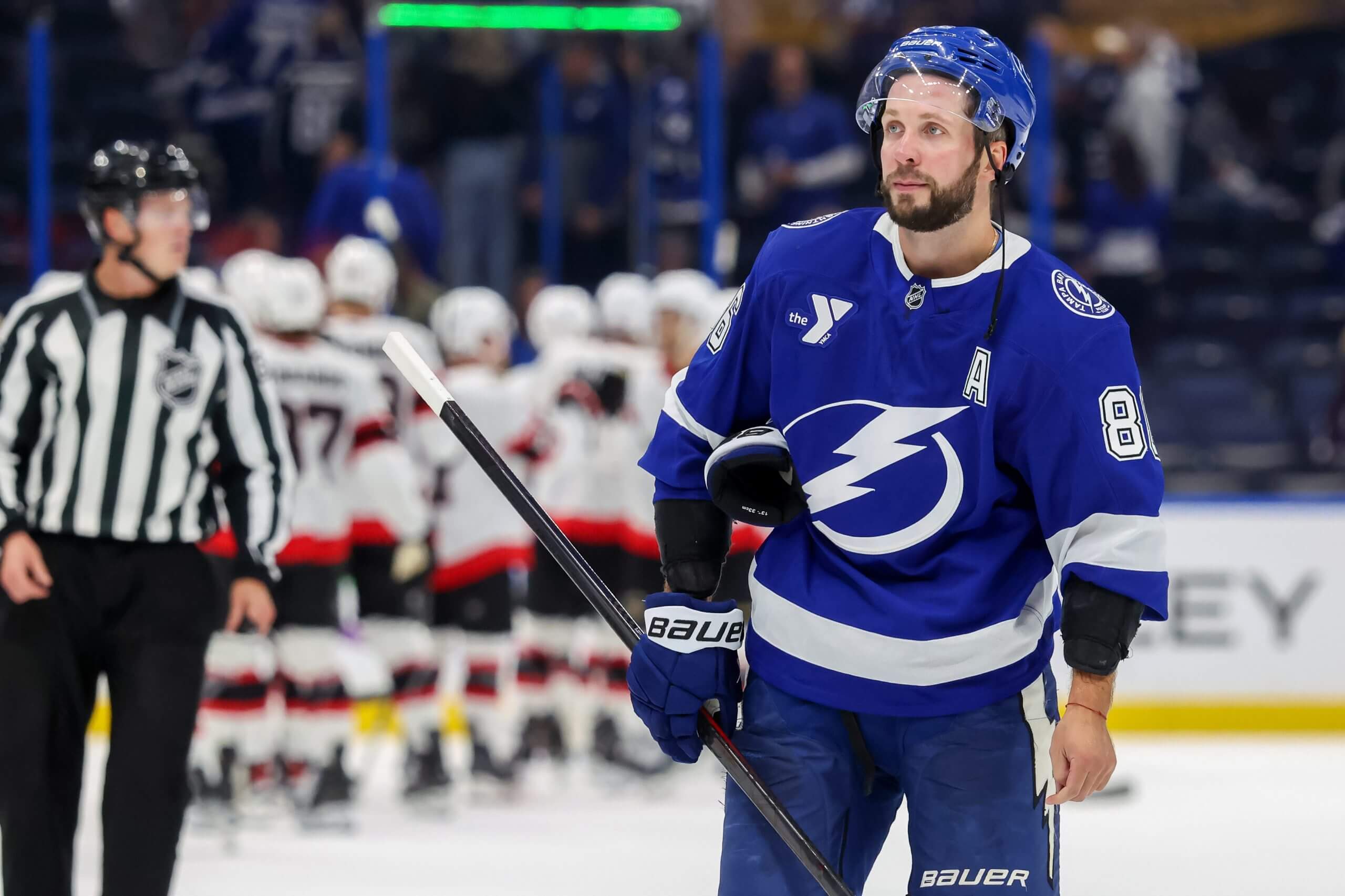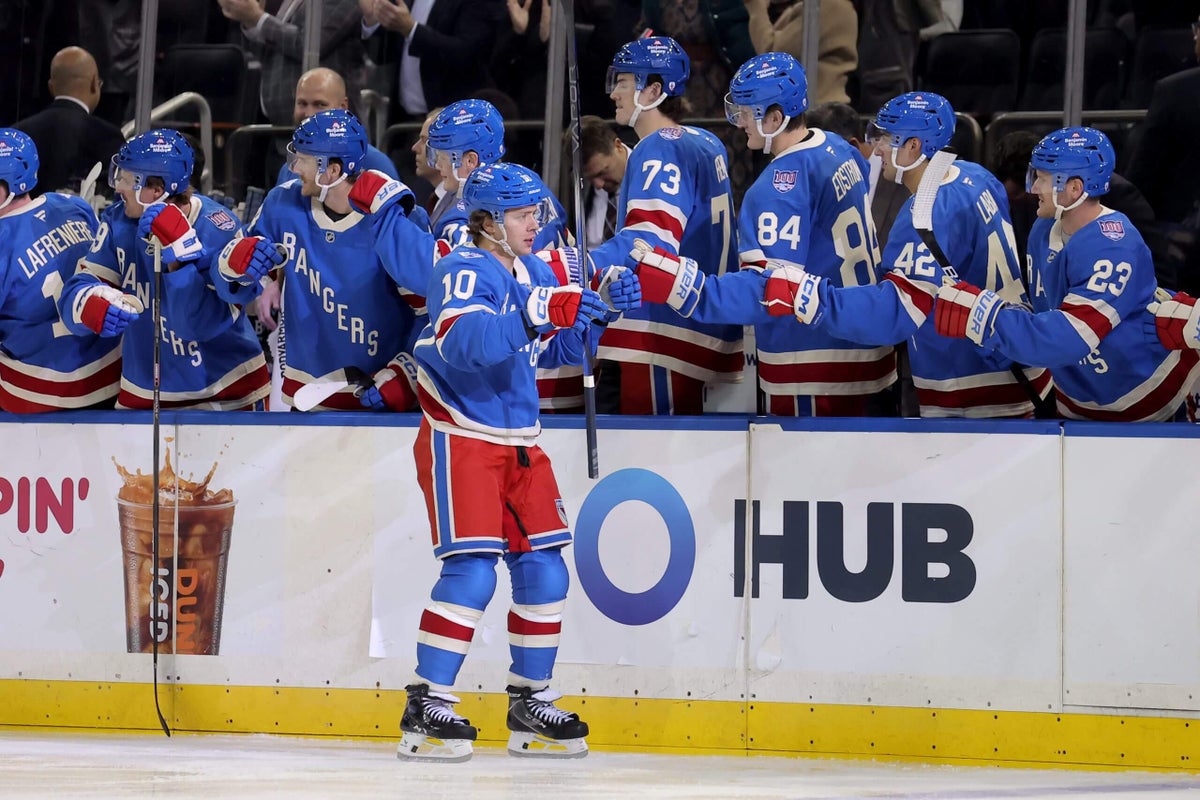Early in the season, it’s difficult to separate fact from fiction. Records can be obfuscated by good fortune. Underlying numbers can be propped up by weak schedules. Everything is still murky.
Within that sludge of early results, though, are some green and red flags that can point you in the right direction — the signal within the noise. Last year, in a November edition of this column, I suggested the New York Rangers might be in more trouble than their 12-4-1 record indicated, a result of poor numbers from the top of the lineup and weak results against stronger teams. They went 27-32-6 the rest of the way.
This year I’m going to do the opposite. Under the hood, there’s a lot more to like about the Rangers’ game than usual. Enough to believe they can get back to the playoffs.
For starters, this is not usually a team that wins the scoring chance battle. That’s a very welcome sight for the Rangers under new coach Mike Sullivan. Through their first eight games, the Rangers have been dominant at five-on-five with 55.6 percent of expected goals, the fourth-best mark in the league. That’s up from 25th last year, 23rd the year before that, and 19th before that.
For this version of the Rangers, actually out-chancing opponents is uncharted territory, and they’ve done so against an average schedule to boot. Puck possession is a hallmark of Sullivan’s teams and the fact he’s been able to port it to the Rangers this early is a good sign. It’s felt at both ends of the ice, too, with the team cutting their xGA/60 from 2.8 to 2.23 and earning 0.25 more xGF/60 in the process.
In that vein, Sullivan has got a lot of early roster wins out of this lineup. Up front, the team’s fourth line has excelled beyond most people’s wildest dreams while the stars are tilting the ice more than before. J.T. Miller has been great in that regard. On the back end, it feels like Sullivan’s early Penguins magic of making any defenseman look good is applying itself to the Rangers’ suspect defensive depth. Will Borgen, in particular, has been a massive standout with a surprising 61 percent xG rate to start.
Put one of the best goalies in the league behind that — Igor Shesterkin has certainly done his part — and it should be a recipe for success.
Should. But obviously with a 3-4-1 record, it hasn’t. Not yet, anyway.
That’s because the Rangers have had a lot of trouble scoring so far, as you may have heard. Team defense and Shesterkin have given the Rangers a third-best 1.87 GA/60 rate so far, but scoring only 2.0 GF/60 puts them ahead of only the Calgary Flames. That’s not ideal and points to one potentially major flaw with Sullivan teams. Over the past three seasons, the Penguins were the league’s worst team at converting expected goals into actual ones. The Rangers currently sit at 1.44 fewer goals than expected per 60 after being an above-average team in the three years prior.
This Rangers team has more finishing talent than those Penguins teams did and it’s unlikely their scoring ability remains that bad all year. Still, it’s also unlikely they finish as much as usual in Sullivan’s system.
Finding the right balance will be key, but it still feels like the Rangers are on the right track given their personnel. A 55 percent xG team, a power play that generates a lot of chances and one of the best goalies in the world is a potentially very scary combination. Once the Rangers start finishing more of their chances, look out.
16 stats1. Fox taking on a tougher challenge
Last season, Adam Fox had a 55 percent xG rate while outscoring opposing teams heavily. This season, Fox has a 55 percent xG rate while outscoring teams heavily. Business as usual, right? Not quite.
Prior to this year, Fox’s role was always optimized for offense. K’Andre Miller’s pair took the toughs, Fox did the rest. It worked, but it did add some question marks regarding Fox’s ultimate defensive aptitude. Great results in a secondary role don’t automatically translate to great results in a shutdown role. That concept was perfectly on display at his heavily criticized 4 Nations tournament.
Fox entered the 2025-26 season with a lot to prove and his work in matchup minutes is going to be one of the major storylines of the year. So far, so good.

Small sample size, but Alex Ovechkin is on pace to set a record for offensive-zone starts. (Patrick Smith / Getty Images)
2. Ovechkin’s usage
The great thing about having a deep team is that it offers a lot of leeway to optimize usage. Case in point: Alex Ovechkin.
The greatest goal scorer of all time is still lethal in the offensive zone, but a mess without the puck. The solution? Have others do all the dirty work while Ovechkin (and Dylan Strome) focus exclusively on offense in advantageous situations.
Over his first seven games, Ovechkin has yet to have a single defensive-zone start, with 30 percent coming in the offensive zone — eight percentage points higher than last year. The record for a single season is 23.7 percent, by the way. That’s while facing the easiest quality of competition on the team (316th hardest among forwards league-wide). The end result is a nice 69 percent xG rate where the Capitals are up 5-0 on the scoreboard.
Spencer Carbery is maximizing Ovechkin’s strengths while minimizing his weaknesses to an incredible degree.
3. Schaefer is a trailblazer
Since the NHL’s tracking era started in 2021-22, there have only been 11 seasons in which a defenseman has had two or more 20-plus mph speed bursts per game. Cale Makar’s 2.6 per game during the 2022-23 season is the highest. Rookie sensation Matthew Schaefer is currently averaging five per game. Five!
To put that into further context, there have only been 14 seasons from forwards above that level; four each from Connor McDavid, Nathan Mackinnon and Brayden Point, and two from Roope Hintz.
It’s difficult to imagine Schaefer keeping up this torrid pace, but it’s clear from this start that he’s an extremely special skating talent. If he can, he has the potential to be a league-wide game-changer.
And it’s not all flash either: Schaefer has the results to match, ranking 16th among defensemen in Net Rating to start.
4. Dobson: The perfect addition
The Canadiens are off to a hot start and it’s no surprise Noah Dobson has been a major part of that. A large group of Islanders fans spent all of last year bemoaning Dobson’s play despite some truly strong underlying numbers, especially defensively. Their loss is Montreal’s gain as Dobson has effortlessly slid into a top-pair role, dominating tough minutes to the tune of a 61 percent xG rate. His presence has pushed everyone into a more appropriate role and has jolted some new life into Mike Matheson.
Arguably the most important aspect, though, is what Dobson’s presence has done for the team’s top line. In 40 minutes together, that combination is up 3-0 with a stunning 81 percent xG. They’ve been dominant, offering a lesson in the importance of a true No. 1 defenseman.
The best teams have someone who can make big plays at both ends of the ice in the most difficult situations. The key to winning matchup minutes is not just having a stay-at-home shutdown force, but having someone who doesn’t have to sacrifice any offense to do it. It’s imperative not to slow down the team’s top forwards in the name of defense.
For Montreal, Dobson looks like someone who can be that kind of player.
5. Rough start in the Sunshine State
The Panthers and Lightning have felt inevitable over the last five years or so, but have looked anything but to start the season. Tampa Bay is off to a dismal 1-3-2 start while Florida isn’t in great shape either at 4-4-0.
While it’s a good bet that both clubs will be fine over the long haul, there are reasons to be a little worried with each team’s opening.
In Tampa Bay, the Lightning may have a top-10 power play, but their work under the surface leaves a lot to be desired. No team takes fewer shots (26.8), shot attempts (71.7) or chances (5.3 xG) than the Lightning with the man advantage. Last year, the Lightning were top 10 in the latter two categories.
In Florida, the Panthers rank 27th in shooting percentage at five-on-five. That’s a continuation of a trend where the team is dead last in finishing over the previous two seasons. Without Aleksander Barkov and Matthew Tkachuk’s offensive upside, it’s difficult to see the Panthers scoring as often as they need to. Also troubling: the team’s scoring chance rate dropping from 2.76 expected goals per 60 to 2.66.

The Lightning are off to a dismal 1-3-2 start to the season. (Mike Carlson / Getty Images)
6. Red Wings’ playoff hopes on the rise
Detroit started the season with a 31 percent chance at making the playoffs, the second-worst mark in a tough Atlantic Division. At the onset, it looked like they might get left behind in a competitive division.
Seven games in, everything is already starting to change.
The state of Florida is in a state of disarray, the Maple Leafs look middling, the Senators aren’t living up to their promise and the Sabres are the Sabres. The Red Wings, though, are looking up after a 5-2-0 start against a tough schedule (fourth hardest). Given the opponents, the team’s 51 percent xG rate — a height they haven’t reached over a full season in a decade — is a good sign.
Those factors combined have already pushed Detroit’s playoff chances north of 50 percent. That’s a level this franchise has only been able to jump to once before (for 15 days during the 2023-24 season, peaking at 69 percent at the end of February) during the Steve Yzerman era.
It’s early, but this could be the year Detroit finally breaks through.
7. Early goaltending returns
Figuring out which goalies are good and which ones aren’t might be one of the most confounding variables when it comes to predicting this wacky sport. Over time, a strong body of work is what matters most — but in between, things can get tricky.
In that vein, it’s great to see three goalies who looked like some of the best in the world one year ago get back on track. All three of Jeremy Swayman, Thatcher Demko and Juuse Saros are coming off tough seasons where they were below-average starters. This year, they’ve started hot with all three sitting in the top 10 for GSAx.
At the top of that list? Spencer Knight. The former “best future goalie in the world” is finally looking the part.
8. The MacKinnon-Necas connection
Through seven games, Martin Necas has five goals and 11 points while Nathan MacKinnon has six and 10. That’s a hot start, but what makes it interesting is that the duo is doing all that damage at five-on-five with Colorado’s power play currently ranking 30th in the league. In 84 minutes on a line with Artturi Lehkonen, Colorado’s top trio has already outscored teams 9-1, scoring 6.5 goals per 60.
9. Utah’s sizzling top six
While the Mammoth sacrificed some depth to make it happen, the addition of JJ Peterka had some big implications for the team’s top-six upside. So far, things are working better than imagined with the two top lines absolutely dominating.
The usual top unit with Clayton Keller, Nick Schmaltz and Barrett Hayton has a 68 percent xG in 51 minutes. The “second” line with Peterka, Logan Cooley and Dylan Guenther sits at 58 percent. On the scoreboard, those two lines have outscored teams 9-4.
That’s a strong basis for a playoff team and it’s what has the Mammoth top five in xG to start. They’re picking up where they left off last year, when Utah led the league in expected goals percentage after the 4 Nations break.
10. The fastest Mammoths in the wild
It’s the second line that feels especially intriguing for one reason in particular: speed. All three of Peterka, Cooley and Guenther are in the top 20 among forwards in 20-plus mph speed bursts per game. Aside from the MacKinnon-Necas connection, Utah might have the fastest forward line in the league.
While part of that is each player’s innate speed, it also seems to be a mandate given Peterka’s change from last season. He jumped from 2.0 bursts per game with Buffalo to 4.7 with Utah, the second-highest jump in the league behind only Kirill Marchenko.
Some of that could be small-sample-size madness, but the pace Utah plays at is something that jumps out while watching. We’ll see if it keeps up to this degree.
11. Bedard’s speed jump
On that note, it’s worth noting that just behind Peterka on the list of change in speed bursts is Connor Bedard. That’s something Bedard vowed to work on during the offseason and it’s certainly paid off. His top speed this year of 22.4 mph is 0.93 higher than his top speed last season. That’s the biggest jump of any player this season.
12. Parayko picking up where he left off
Last season, Colton Parayko found new life thanks to a new coach and a new partner. Under Jim Montgomery and with Cam Fowler, Parayko looked like his best self again. He finished the season especially strong and that’s seemingly carried over to the start of this season.
In Parayko’s last six games of the 2024-25 season, he had a stunning 70 percent xG. In his first six games of the 2025-26 season, he’s been at 67 percent. Put those two together and it’s the first time Parayko has had a 12-game stretch with a 65 percent xG or better since the 2018-19 season. That’s a pretty good omen for the Blues.

The Flames have been outscored 10-3 with MacKenzie Weegar on the ice at five-on-five. (Alex Goodlett / Getty Images)
13. Veteran defensemen struggle
It’s still extremely early so things can change quickly, but there are two very interesting names starting the season near the bottom of the Net Rating leaderboard: MacKenzie Weegar and Jared Spurgeon.
The two analytics darlings have had a rough go at five-on-five, getting outscored badly while being unusually out-chanced. The Flames are down 10-3 with a 47 percent xG in Weegar’s minutes, while the Wild are down 7-0 with a 42 percent xG in Spurgeon’s minutes.
Is this just an early-season rough patch for two strong veteran defenders, or is it the beginning of a real slide in effectiveness?
14. Does Foote know Elias Pettersson is (kind of) back?
In 2022-23, Elias Pettersson’s best season, he scored 2.23 primary points per 60 at five-on-five and earned 53 percent of expected goals with a rate that was 0.6 better per 60 relative to teammates. He also outscored opponents heavily.
In his first seven games of the 2025-26 season, Pettersson has scored 2.25 primary points per 60 at five-on-five and earned 53 percent of expected goals with a rate that was 0.6 better per 60 relative to teammates. He’s also outscoring opponents heavily.
Under the surface, Pettersson looks elite again on a per-minute basis. Which is what makes it so strange that Pettersson is playing a full two minutes fewer per game at five-on-five than he has the past four seasons. Pettersson sits seventh among all Canucks forwards with just 11.4 five-on-five minutes per game.
Part of the reason that Pettersson’s efficiency is back may be due to the lighter load. There are still parts of his game that are concerning, like his shot rate dropping and his work on the power play. Still, it feels more likely that a normally elite player has bounced back to his old self. Let him cook!
15. Can Vegas’ power play keep thriving without Stone?
Last year, in one of the midseason editions of 16 Stats, I noticed Jack Eichel had a strangely high rate of secondary assists on the power play. After looking deeper, it was clear that Vegas had a set play with him, Stone and Pavel Dorofeyev (or Tomas Hertl). That same play has been a big part of Vegas’ strong start on the power play this season. Eichel has eight secondary assists, Stone has six primary assists and Dorofeyev and Hertl have combined for six goals. Yeah, it still works.
Now, with Stone out week-to-week, Vegas is going to find out whether it still works with Mitch Marner in his place.
That should be simple enough, as Marner is one of the game’s premier playmakers, but it’s no guarantee given how comfortable he’s become in his spot at the top of the formation. It’s still early, but the first game (against a very tough PK) saw Vegas struggle to generate chances with the man advantage.
16. Blue Jays’ NHL comparable
On Monday night, the Toronto Blue Jays advanced to the World Series, pulling off what seemed like a highly improbable feat at the start of the MLB season. Going into the year, the Blue Jays had the 20th-best odds of winning at +6000, according to Sports Odds History.
I was curious what that meant in NHL terms; which team was closest to that. The answer: This year’s Vancouver Canucks, who started the year as the NHL’s 19th-ranked team by Stanley Cup odds at +6000.
In the salary cap era, only two NHL teams have made the Stanley Cup Final with odds that long: the 2017-18 Golden Knights (+15000) and the 2005-06 Hurricanes (+6000).
Data via Evolving Hockey, Hockey Stat Cards, Natural Stat Trick and Puckalytics
